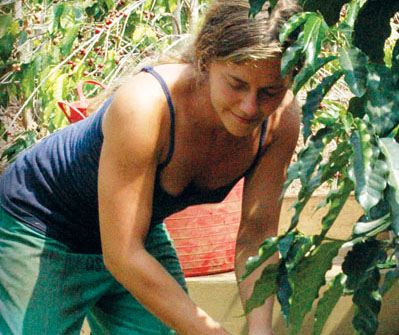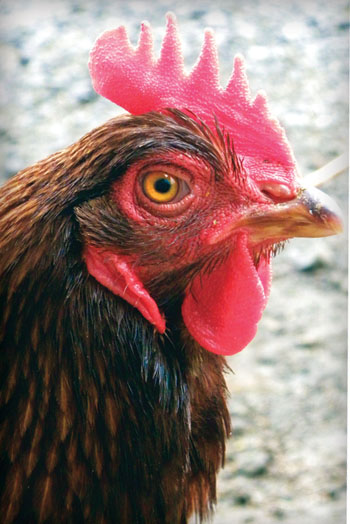
Grace Under Stress: Kona Orchid Society
 By Catherine Tarleton
By Catherine Tarleton
Older than the volcano, with roots in dinosaur days, orchids were alive and well as far back as 80 million years ago, according to the Harvard biologist who managed to date fossilized pollen from a now-extinct bee preserved in amber.
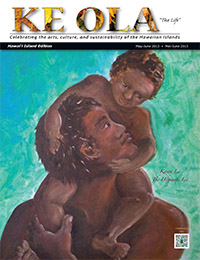
Agelessly sexy, the word orchid comes from “orchis,” the Greek word for testicle (because of its root shape), and shares its moniker with a mythical rogue. Orchis was the son of a satyr and a nymph, whose lustful transgressions caused him to be killed by the Fates, but remembered ever after with a flower.
From ancient Greece to modern Hawai‘i, orchids grow around the world, and on every continent except Antarctica. With over 22,000 species in 800 genera and 100,000+ hybrids, orchids are the largest and most diverse plant family on the planet.
“There are 32 endemic orchids in Colorado, and the State Flower of Minnesota is an orchid,” said Zeller. “They pop up through the snow in the Himalayas and they grow underground in Australia.”
Talk about thriving under stress.
“Orchids need stressors,” said guest speaker Clayton Lowe at the March meeting of the Kona Orchid Society (KOS). Lowe, a longtime orchid grower in Kea‘au, said he’s learned that at least some orchids thrive and bloom their utmost under stress. “In 1984, I bought my first orchid from Akatsuka Orchids and shipped it home to Albuquerque,” said Lowe. “It took about six weeks for me to kill it. I spent the next year reading, talking to people, and learning all about orchids.”

Continuing the process, Lowe joined about 60 KOS members and guests—hardworking men and women of all ages who compared notes on elevation, discussed fertilization and pollination in-depth, spouted Latin nomenclature like college professors, and identified each other by “warms” and “cools.” A wide spectrum of brilliant blooms from glowing white to deepest magenta, flame orange, shy pinks and more elicited ooh’s and ah’s from casual hobbyists and professional growers alike during show and tell.
Learning is much of what KOS is all about. New or potential members are warmly welcomed to monthly meetings at Hualālai Academy’s Bridge House. And KOS enthusiasts, like most gardeners, are generally eager to share tips, techniques, advice, and keiki plants—along with their potluck supper. Like the beautiful flowers that captivate them, the beautiful people of KOS seem to be at their best when pressed.
Maggie Adorme, for example, founded KOS in 1987 with her late husband Bob, and is the club’s longest-term member. At 78 years young, having retired from the Royal Kona Resort where she worked 30 years, she has three sons, 10 grandchildren, 10 great-grandchildren, and more than a 1,000 orchids.
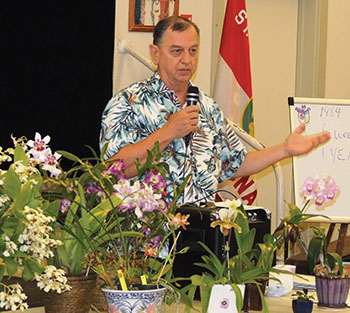
Adorme continues to work her two-acre coffee farm by herself and spends her spare time cultivating more orchids to cherish on her own or share with others. She and her friend and former past president Kathy Penwell are continually on the hunt for new and different orchid gems for their collection.
“I grab her and go holo holo to the nurseries,” said Penwell, who teaches at West Hawai‘i Explorations Academy (WHEA). “I grow roses and orchids…they don’t talk back like kids do,” jokes Penwell. She has been working on orchid-related curricula in the classroom. “I’ve got 20 students doing orchid projects this year,” she said.
Vice President Jan Rae is also an educator, a retired special education teacher from New York.
“It was a labor of love,” said Rae. “There was never a day that I did not want to go to work, not in 25 years of teaching.” A fabulous septuagenarian like Adorme, Rae is another who seems to bloom under stress.
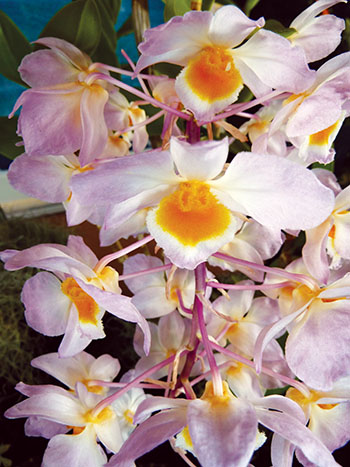
She just finished co-producing The Wizard of Oz at Aloha Theatre with husband Joel Gimpel, music director. She’s also Vice President of the Bowling Alley Women’s Association and active with disabled children’s programs with Therapeutic Horsemanship of Hawai‘i. “My life is music, flowers, and children,” said Rae. “And bowling balls.”
Rae grew roses before she moved to Hawai‘i and fell in love with orchids. Her favorite? “Cattleyas. “Those are the big ones you get when you go to the prom or for mother of the bride,” said Rae, who also likes to eat the occasional blossom. “Dendrobiums are pretty tasty,” she added.
Rae attributes her youthful spark to a life of hard work, and she continues to work hard, educate herself, and cultivate passion for orchids.
“It’s a challenge,” said Rae. “I want to keep learning and doing better. I’m not nearly as good as most of these growers. We have some amazing growers in the Orchid Society, a few who really put me to shame. Their orchids are absolutely incredible.”
KOS’ guest speakers, workshops and other activities, are funded for the most part by a two-day veritable “salad” of orchids, the Society’s annual Mother’s Day Orchid Show and Sale.
Chaired by KOS member Bob Zeller for the last 20 years, the festivities include: juried orchid competition in 10 categories, plant sales, orchid supply sales, artists and crafters, free classes, and the specialized fellowship of orchid-lovers, like Zeller and wife Phoenicia.
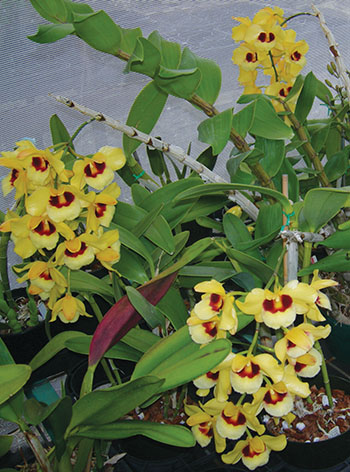
“My wife actually found an orchid on the land we were living on and wanted to know what it was,” said Zeller. “We went to an orchid meeting and became addicted.”
The Zellers, who run Pele’s Island Plants in Ocean View, look forward to selling orchids for the rest of their lives. His favorite? “Beallara Marfitch Howard’s Dream,” said Zeller. “I just like purples.”
Zeller said the Mother’s Day Show and Sale first began in the parking lot at Lanihau and then moved to Hale Halawai and added the crafts component. The present location at Old Airport Park allowed KOS to expand significantly, providing ample free parking, and more than double the number of vendors. About 17 vendors will include orchid plants, herbs, water plants, day lilies, and desert roses. Other fun items are chocolates, ceramics, lava pots, hot dogs and homemade popsicles from Bubba’s Big Dogs, and all kinds of jewelry.
Returning orchid jeweler Peter Honeyman with RealFlowerJewelry.com is a botanist from Central Africa who worked with flowers his whole life. He developed a patented technique of preserving living Hawai‘i-grown orchids, other flowers, and tiny limu seaweed. The technique allows the blossoms to look surprisingly fresh and stay pliable for many years so they can be worn as pendants, earrings, hair ornaments, and other jewelry.
Not an orchid but still worth mentioning is one of his more unique “designs,” the delicate naupaka, which looks like only half a flower. Made famous by the legend of two lovers separated by a jealous Pele, one variety of naupaka grows in higher elevations, and another down by the ocean. Sharing a printed copy of the story, Honeyman offers something of Hawaiian culture with every naupaka sale.
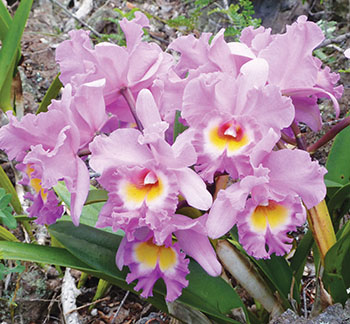
Orchids are a natural part of Hawaiian culture, with three endemic Hawaiian species still in existence: (Hawai‘i Bog Orchid (Platanthera holochila), Hawai‘i Jewel Orchid (Anoectochilus sandvicensis) and ‘Awapuhi-‘o-Kanaloa (Liparis hawaiensis). Their shyer blooms may have kept them out of the spotlight, and thus the family of missionary William Shipman is credited with bringing the first commercial orchids to the Kingdom and the Island of Hawai‘i, near the turn of the 20th century.
In 1940, William’s grandson and avid orchid grower Herbert C. Shipman registered a hybrid as Vanda “Clara Shipman Fisher” with the Royal Horticulture Society. Named for one of his sisters, a cutting of the original plant survives at the family’s Reed’s Island property to this day, according to Hilo Orchid Society. (Interestingly, Herbert was also instrumental in saving the nēnē from extinction, by creating a nēnē sanctuary, now located within Hawai‘i Volcanoes National Park.)
To learn more about and risk obsession with, the world of orchids, visit the Kona Orchid Society’s annual Mother’s Day Orchid Show and Sale at the Old Airport Park in Kailua-Kona. Admission is free and the event is open 9 am–6 pm on Friday, May 10 and 8 am–5 pm on Saturday, May 11. ❖
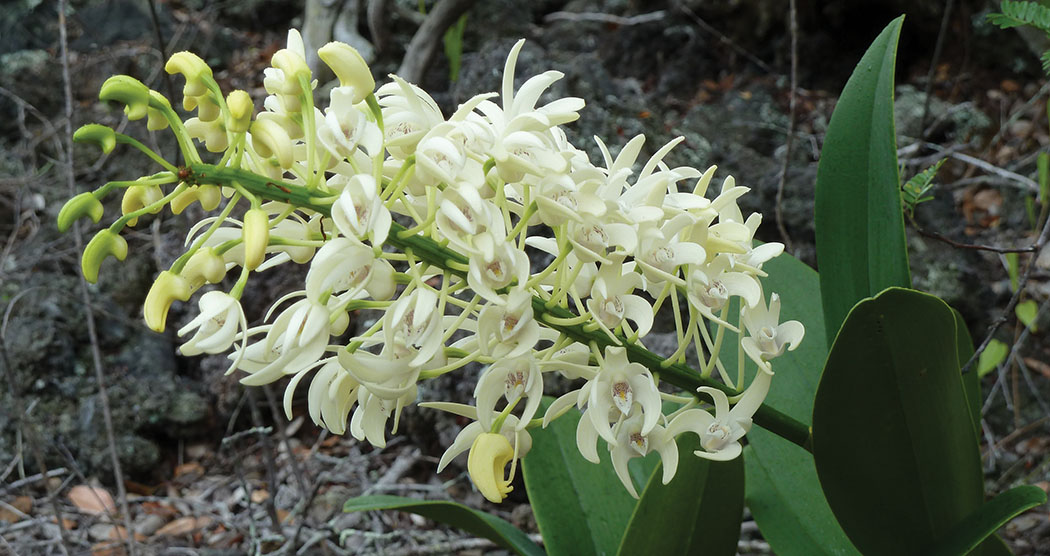
For more information: KonaOrchidSociety.org, KOS@konaorchidsociety.org
Contact writer Cathey Tarlton: catherinetarleton@gmail.com
